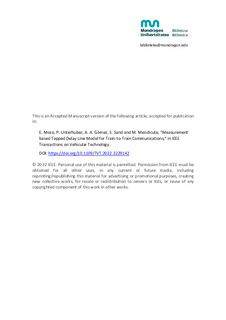Título
Measurement based Tapped Delay Line Model for Train-to-Train CommunicationsOtras instituciones
Deutsches Zentrum für Luft- und RaumfahrtVersión
Postprint
Derechos
© 2022 IEEEAcceso
Acceso embargadoVersión del editor
https://doi.org/10.1109/TVT.2022.3229142Publicado en
IEEE Transactions on Vehicular Technology Editor
IEEEPalabras clave
Rail transportation
Channel models
Scattering
Doppler effect ... [+]
Channel models
Scattering
Doppler effect ... [+]
Rail transportation
Channel models
Scattering
Doppler effect
Delays
Indexes
Time measurement [-]
Channel models
Scattering
Doppler effect
Delays
Indexes
Time measurement [-]
Resumen
Train-to-train (T2T) communication is proposed as an auxiliary safety-guaranteed measure for railway communications. Vehicular communication standards have been supporting railway use cases and T2T co ... [+]
Train-to-train (T2T) communication is proposed as an auxiliary safety-guaranteed measure for railway communications. Vehicular communication standards have been supporting railway use cases and T2T communications. It is essential to consider the propagation characteristics of railway environments with dedicated T2T channel models for simulation and testing of vehicular communication standards. In this paper, we propose six tapped delay line (TDL) channel models for T2T communications in Hilly Terrain and Railway Station. The measurement based proposed channel models consider different T2T distances and relative speeds of up to 50 km/h with trains moving in an approaching maneuver. Also, a study about the Doppler-delay behavior in the considered scenarios is presented using the scattering function. The proposed TDL channel models as well as the measured propagation characteristics are used in a 802.11bd simulation framework. Both simulation results, which are based on the TDL channel models or on the measurements, are compared to each other. The results show a very good match between the TDL channel models and the measurement data and indicate a good accuracy of the theoretical derivations and the simulation method. [-]
Sponsorship
Comisión EuropeaID Proyecto
info:eu-repo/grantAgreement/EC/H2020/876038/EU/Intelligent Secure Trustable Things/InSecTTColecciones
- Artículos - Ingeniería [728]





















